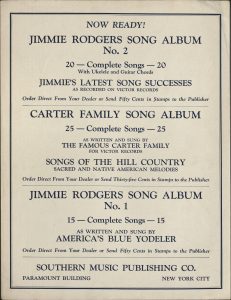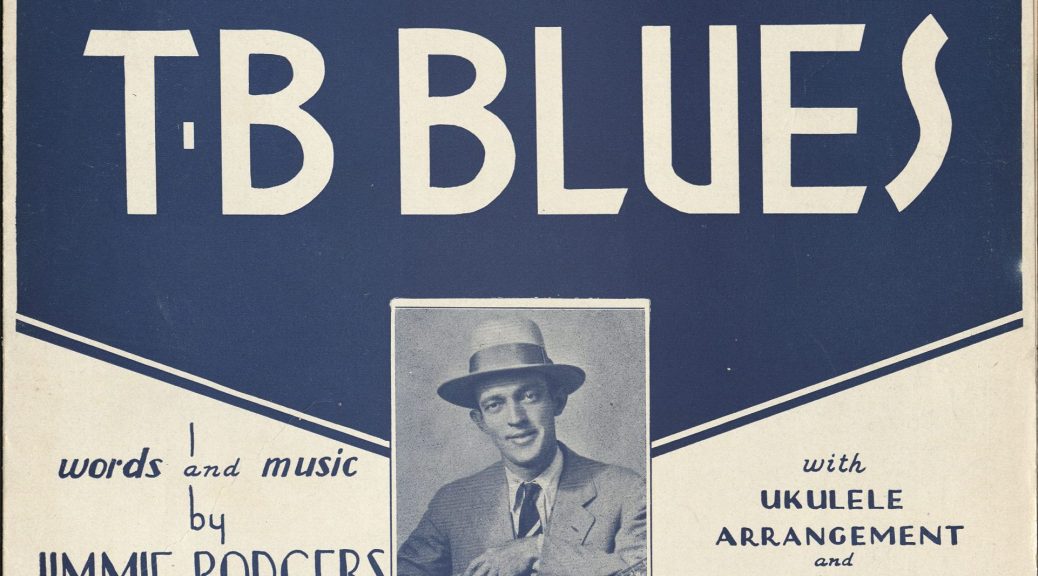Post contributed by Roger Peña, M.Ed., Research Services Librarian
I’m fightin’ like a lion, Looks like I’m going to lose.
‘Cause there ain’t nobody, ever whipped the T.B. blues
The above lyrics come from the 1931 song, “T.B. Blues” by pioneering country singer, Jimmie Rodgers. They describe a young man accepting his fate and losing the fight against tuberculosis, or TB.
The published sheet music for “T.B. Blues’‘ is housed at the David M. Rubenstein Rare Book & Manuscript Library’s larger collections of published sheet music, and is just one of thousands that make up the library’s collection.

By the 20th century, sheet music had long been a tradition in the music industry as a way for customers to immerse themselves with their favorite songs but also an opportunity for companies to advertise their artists and products. The sheet music for “T.B. Blues’” was published in 1931 by the Southern Music Company – though it was based in New York City. It includes the then standard “Try it on your Piano” introduction page and advertisements for other Jimmie Rodgers songs and that of the Carter Family and band-leader Hoagy Carmichael. The front cover features a portrait of Jimmie Rodgers in his signature suit and straw hat, under a banner with the song title and the curious inclusion of a moonshine bottle, a pair of dice, and the silhouette of a man laying in bed with his chest to his knees, perhaps an allegory to the pain suffered by tuberculosis patients.
Known as the “Singing Brakeman,” a reference to his time working on railroad lines, Rodgers is considered the “father of country music” for his influence across country, rhythm and blues, bluegrass and rock n’ roll. An inductee of the Rock n’ Roll Hall of Fame and Country Music Hall of Fame, Rodgers is known for such hits as “In the Jailhouse Now,” “Blue Yodel No. 9” (with Louis Armstrong) and “T for Texas,” and has been covered by legendary artists Bob Dylan, Willie Nelson, Johnny Cash and Allison Krauss, among others. Tragically, his promising career lasted only six years and was cut short after a long battle with tuberculosis, when he succumbed to the disease in 1933, at the age of 35.

Got me worried soul, I can’t even sleep at night
I’ve got the T.B. blues
“TB” BACKGROUND
In Jimmie Rodgers’ lifetime, tuberculosis was “one of the two leading causes of death in the early 1900s” and the “dominant chronic infectious disease of the first half of the twentieth century.” Tuberculosis — known also as consumption, phthisis, white plague, and “the robber of youth” throughout history — is caused by the bacteria, mycobacterium tuberculosis.
The earliest written description of TB dates back three millennia to ancient India and in AD 174, the Greek physician Galen described its symptoms as “fever, sweating, coughing and blood stained sputum.” Thought to be hereditary until the late 19th century, German scientist, Robert Koch, discovered that tuberculosis was an airborne infectious bacterial disease that could be transmitted from person to person.
According to a study by Harvard University Library, tuberculosis caused more deaths in industrialized countries than any other disease during the 19th and early 20th centuries. However, a romanticized view of tuberculosis had sprung up in the 1800s as the disease came to be associated with artists and literature. Some believed that suffering from the disease increased creativity, “heightened sensitivity and spiritual purity.” Writer Robert Louis Stevenson suffered from tuberculosis for most of his life and artists such as Emily Bronte, John Keats, and Frederic Chopin all died from the disease at an early age.
Alexander Dumas claimed, “It was the fashion to suffer from the lungs; everybody was consumptive, poets especially; it was good form to spit blood after each emotion that was at all sensational” while Lord Byron quipped that he “should like to die of consumption”.
Yet for many suffering from tuberculosis, the disease could feel like a slow death. Tuberculosis can attack the body in different ways, from the lungs to the kidneys, brain and spine. TB bacteria can settle in the lungs and begin to grow and move through the blood to other parts of the body. Not all who contract tuberculosis become sick leading to the distinction between Latent TB Infection (asymptomatic) and TB Disease (symptomatic).
Like many who suffered from the progressive form of tuberculosis, Rodgers’ battle was prolonged and extremely painful, coughing up bloody sputum for years and suffering from chronic fatigue. At the time of the recording of “T.B. Blues” in 1931, Rodgers had already been living with the disease (the symptomatic TB Disease) for over seven years. He had been diagnosed in 1924 by a family physician after suffering a hemorrhage (Porterfield, p. 53).
When it rained down sorrow, It rained all over me
‘Cause my body rattles, Like a train on that old S.P. [Southern Pacific RR]

Prior to the innovations of vaccines, medication, and antibiotics that have helped fight tuberculosis, most physicians could only prescribe a nutritious diet, rest and fresh air. In the late 1800s and early 20th century, tuberculosis sanatoriums were established throughout the United States and Europe where TB patients could isolate and rest.
However, relaxation, bedrest, quarantine and sanatorium care weren’t necessarily options for those suffering from poverty. Not working meant not getting paid, and the same was true for Jimmie Rodgers. Particularly for a musician just reaching stardom, taking time from work was not an option. He spent time in sanatoriums and even lived in Asheville, NC for its cooler climate and mountain air; but he continued to perform, even against the recommendations of physicians and family (Porterfield, p.53). Rodgers would on occasion stumble out of bed to perform while fighting a fever and went so far as to tape plaster to his ribs to dull the pain and prevent from breathing too deeply. When he couldn’t stop coughing onstage, fans were known to applaud sympathetically and shout, “Spit ‘er up, Jimmie and sing some more” (Porterfield; p. 115; 279).
Eventually, the disease and its complications would prove too much. Jimmy Rodgers lost his battle with tuberculosis on May 26, 1933. Ever the tireless performer, Rodgers spent his final days recording music in a New York studio, cutting his last record two days before his death.
TB’s Impact

Tuberculosis affected people in all corners of the United States and was especially hard on the working class, immigrants and African American communities. Low quality living and working conditions allowed the pathogen that spread tuberculosis to thrive in poorly ventilated and cramped homes and places of work. In the city of Durham, NC (home of Duke University), the disease was particularly difficult on the African American community, which made up roughly one-third of the city’s population in the first half of the 20th century. A 1938 report from Lincoln Hospital – the segregated African American hospital – referred to tuberculosis as “the most serious problem among the [Black community] of Durham County.”

The Duke Endowment, which continues to fund the university and Duke University Hospital, among other endeavors, donated hundreds of thousands of dollars to sanatoriums throughout North and South Carolina in the 1920s and ‘30s. Prior to the founding of the hospital in 1930, there were even plans to build a tuberculosis center. The Durham County prison would be converted into a tuberculosis sanatorium in 1943/1944 to serve the local residents suffering from the disease. The Durham County Tuberculosis Sanatorium would be funded through an appropriation of $25,000 and the profits from ABC stores in the Durham community (Anderson, 328).
Though much has been done to prevent the spread of the disease, today, it’s estimated that 13 million Americans carry the Latent TB Disease. Globally, tuberculosis continues to be one of the deadliest diseases, with one quarter of the world’s population (2 billion people) infected with the TB bacteria and over 1.5 million deaths per year.
The Rubenstein Library’s History of Medicine Collections contains hundreds of print materials related to the history of tuberculosis and its impact on society and culture. The Rubenstein Library is also home to an extensive collection of American and world sheet music including the Manuscript Sheet Music collection,circa 1800s-1900s, the American sheet music collection,1850-1940. and the Historic American Sheet Music (digitized Collection) including “T.B. Blues” by Jimmy Rodgers.

References
Anderson, Jean B. Durham County: A History of Durham County, North Carolina. Durham: Duke University Press, 2011. https://find.library.duke.edu/catalog/DUKE004941755
Porterfield, Nolan. Jimmie Rodgers: The Life and Times of America’s Blue Yodeler. Urbana: University of Illinois Press, 1979. https://find.library.duke.edu/catalog/DUKE000339681


